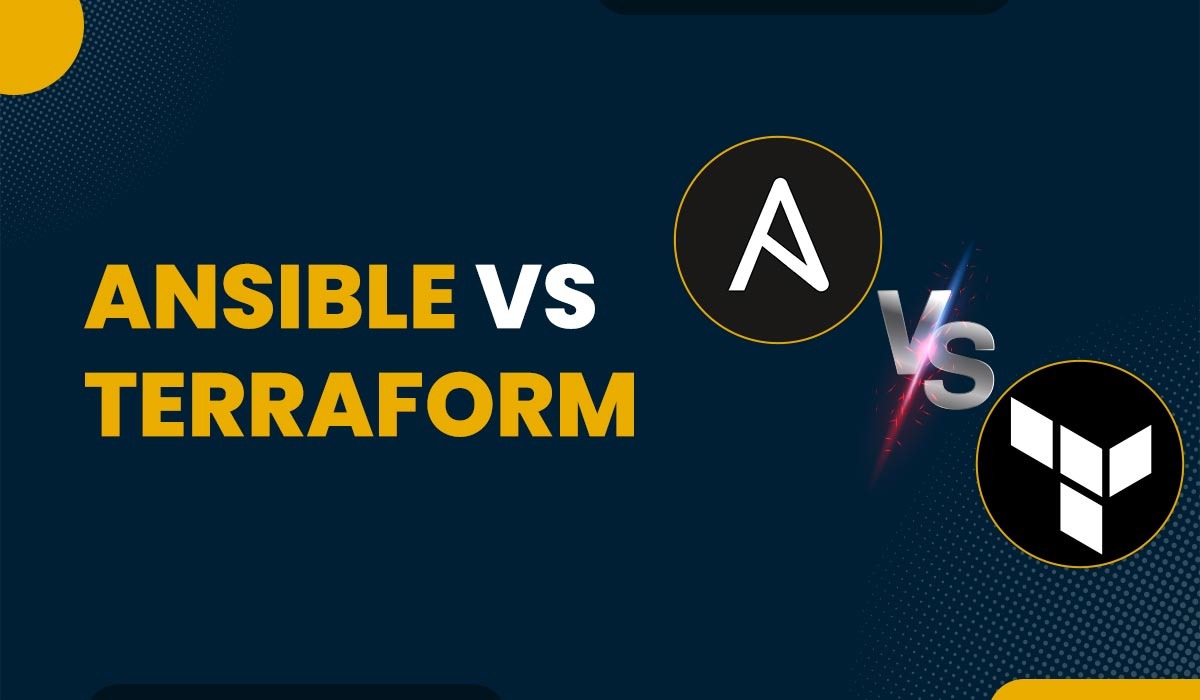There are no items in your cart
Add More
Add More
| Item Details | Price | ||
|---|---|---|---|

In the world of DevOps and cloud infrastructure management, Infrastructure as Code (IaC) has become the foundation of automation and scalability. Two of the most popular IaC tools are Terraform and Ansible, both are widely used.
Think of it like this: Terraform is great for setting up your infrastructure, like creating servers, networks, and databases in the cloud. On the other hand, Ansible is awesome for configuring those servers, like installing software, setting up users, or updating applications.
What is Terraform
Terraform is primarily an Infrastructure as Code (IaC) tool focused on infrastructure provisioning and management. It allows users to define and manage cloud resources (like virtual machines, networks, databases) across various cloud providers (AWS, Azure, Google Cloud) and on-premises environments using a declarative configuration language (HashiCorp Configuration Language - HCL).
What is Ansible ?
Ansible is primarily a configuration management and automation tool. It excels at automating tasks like software installation, system configuration, application deployment, and orchestration of IT processes. Ansible uses Playbooks written in YAML to define tasks and configurations, and it operates agentlessly, communicating with target machines over SSH or WinRM.
Difference Between Terraform Vs Ansible
1. Primary Focus
Terraform: Primarily an Infrastructure as Code (IaC) tool focused on provisioning and managing infrastructure resources. It creates VMs, networks, databases, and other infrastructure components. It emphasizes defining the desired state of infrastructure and ensures that state is achieved.
Ansible: Primarily a configuration management and automation tool. It configures existing infrastructure, deploys applications, and automates operational tasks like patching or software updates.
2. Type
Terraform: Infrastructure as Code (IaC) tool used to provision and manage cloud infrastructure resources.
Ansible: Configuration management tool used to automate tasks like software installation, updates, and system configuration.
3. Language/Syntax
Terraform: Uses HCL (HashiCorp Configuration Language), a declarative language designed specifically for infrastructure definitions.
Ansible: Uses YAML, a simple and human-readable language for writing playbooks and defining automation tasks.
4. Approach
Terraform: Declarative – you define the desired state, and Terraform figures out how to reach that state.
Ansible: Imperative – you define specific steps to execute in order to reach the desired state.
5. Primary Use Case
Terraform: Best for provisioning infrastructure like servers, networks, databases, and load balancers in multi-cloud environments.
Ansible: Best for configuring systems, deploying applications, and running operational tasks on provisioned infrastructure.
6. Execution Method
Terraform: Builds an execution plan before applying changes. Uses dependency graphs to determine the correct order of operations.
Ansible: Executes tasks sequentially as written in playbooks. No built-in planning phase.
7. State Management
Terraform: Maintains a state file to track infrastructure. This helps Terraform understand what exists and what needs to change.
Ansible: Stateless by default. It does not track system state unless integrated with external tracking mechanisms.
8. Agent Requirements
Terraform: No agents required; communicates directly with cloud provider APIs.
Ansible: Agentless, communicates over SSH/WinRM with nodes. Requires minimal setup.
9. Modules & Reusability
Terraform: Uses modules to group and reuse infrastructure code across environments.
Ansible: Uses roles and modules to organize, reuse, and share configuration tasks.
10. Cloud Support
Terraform: Strong multi-cloud support (AWS, Azure, GCP, and many others via providers).
Ansible: Supports cloud integration but is primarily used for on-instance configuration, not full infrastructure provisioning.
11. GUI Options
Terraform: Primarily CLI-based. Offers GUI and collaboration features via Terraform Cloud.
Ansible: Primarily CLI-based. Ansible Tower provides a GUI for orchestration and monitoring.
12. Scalability
Terraform: Scales efficiently for large and complex infrastructure with dependency-aware graphs.
Ansible: Scales well for configuration across many servers, but performance can drop with thousands of nodes due to sequential execution.
Which IaC Tool Should You Use in 2025 ?
It depends on your goal. If you are focused on creating or managing infrastructure like provisioning servers, setting up networks, or creating cloud resources such as EC2 instances or S3 buckets Terraform is the right tool.
It works best with cloud providers like AWS, Azure, and Google Cloud, and follows a declarative approach, where you describe the desired state and let Terraform handle the rest. It also gives you the ability to track, plan, and review changes before applying them, which is great for infrastructure version control.
On the other hand, if you want to configure servers, such as installing software, setting system configurations, or managing services after the infrastructure is already set up, Ansible is the better choice. Ansible is agentless, easy to use over SSH, and uses simple YAML-based playbooks to define tasks, making it ideal for managing server state and automation.
In many real-world scenarios, teams use both tools together: Terraform is used to provision the infrastructure, and Ansible is used to configure and manage what's inside those machines.
Conclusion
Terraform and Ansible are not direct competitors but complementary tools. Terraform is best for provisioning infrastructure like servers, networks, and databases, while Ansible excels at configuring systems and automating deployments.
In 2025, the smartest approach for DevOps teams is often to use both together — Terraform to build and manage infrastructure, and Ansible to configure and automate it. This combination ensures reliable, scalable, and fully automated environments.
Fri Aug 29, 2025
"DevOps is the union of people, processes, and products to enable continuous delivery of value to our end users." - Donovan Brown
Ayushman Sen is a DevOps Engineer at CloudDevOpsHub with a passion for cloud technologies and automation. He enjoys writing blogs to share his DevOps knowledge and insights with the community. A true DevOps enthusiast, Ayushman is also passionate about traveling, listening to music, and playing musical instruments.

Ayushman Sen
DevOps Engineer at CloudDevOpsHub